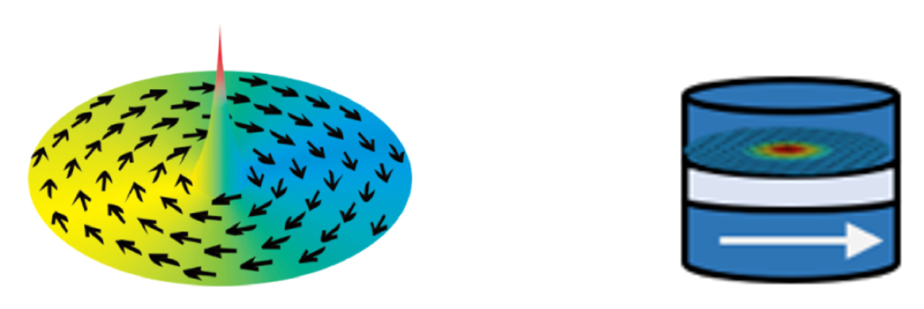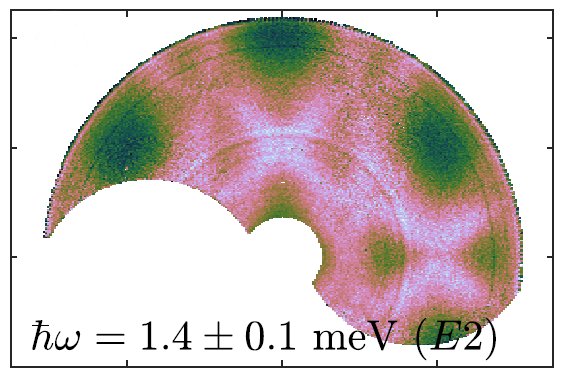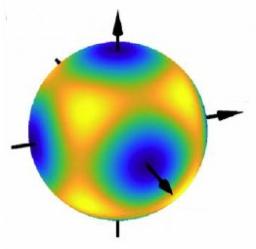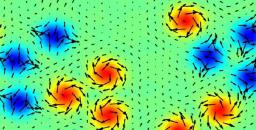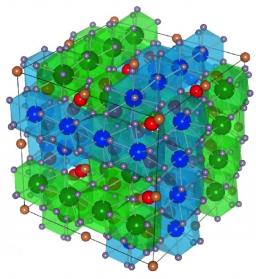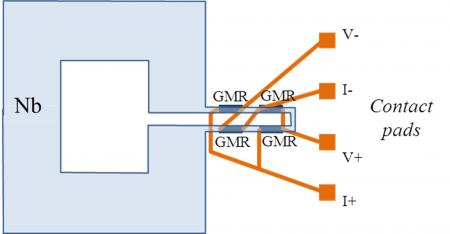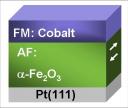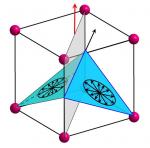Reentrant spin glasses are frustrated disordered ferromagnets developing vortexlike textures under an applied magnetic field. Our study of a Ni0.81Mn0.19 single crystal by small angle neutron scattering clarifies their internal structure and shows that these textures are randomly distributed. Spin components transverse to the magnetic field rotate over length scales of 3–15 nm in the explored field range, decreasing as field increases according to a scaling law. Monte Carlo simulations reveal that the internal structure of the vortices is strongly distorted and differs from that assumed for “frustrated” skyrmions, built upon a competition between symmetric exchange interactions. Isolated vortices have small noninteger topological charge. The vortices keep an anisotropic shape on a three-dimensional lattice, recalling “croutons” in a “ferromagnetic soup.” Their size and number can be tuned independently by the magnetic field and concentration x (or heat treatment), respectively. This opens an original route to understand and control the influence of quenched disorder in systems hosting nontrivial spin textures.
Magnetic sensors based on the displacement of a vortex core in a magnetic tunnel junction are currently proposed to obtain linear field responses over a large range (typically a few tens of mT) while keeping a very good sensitivity for various applications (automotive, biomedical). However, these sensors present a very important low frequency magnetic noise which limits their detection performance. In this work, this noise has been characterized and studied as a function of the vortex dynamics and this has allowed to determine solutions to reduce it. The use of AC excitation in these sensors by applying a magnetic field, a DC current or radio frequency (RF), induces a dynamic of the vortex core that prevents it from getting stuck in metastable states, the main source of magnetic noise. "Shaking" the vortex core in this way results in a significant reduction of low frequency noise.
M. Ruminy, S. Guitteny, J. Robert, L.-P. Regnault, M. Boehm, P. Steffens, H. Mutka, J. Ollivier, U. Stuhr, J. S. White, B. Roessli, L. Bovo, C. Decorse, M. K. Haas, R. J. Cava, I. Mirebeau, M. Kenzelmann, S. Petit, and T. Fennell
Tb2Ti2O7 presents an ongoing conundrum in the study of rare-earth pyrochlores. Despite the expectation that it should be the prototypical unfrustrated noncollinear Ising antiferromagnet on the pyrochlore lattice, it presents a puzzling correlated state that persists to the lowest temperatures. Effects which can reintroduce frustration or fluctuations are therefore sought, and quadrupolar operators have been implicated. One consequence of strong quadrupolar effects is the possible coupling of magnetic and lattice degrees of freedom, and it has previously been shown that a hybrid magnetoelastic mode with both magnetic and phononic character is formed in Tb2Ti2O7 by the interaction of a crystal field excitation with a transverse-acoustic phonon. Here, using polarized and unpolarized inelastic neutron scattering, we present a detailed characterization of the magnetic and phononic branches of this magnetoelastic mode, particularly with respect to their composition, the anisotropy of any magnetic fluctuations, and also the temperature dependence of the different types of fluctuation that are involved. We also examine the dispersion relations of the exciton branches that develop from the crystal field excitation in the same temperature regime that the coupled mode appears, and find three quasidispersionless branches where four are expected, each with a distinctive structure factor indicating that they are nonetheless cooperative excitations. We interpret the overall structure of the spectrum as containing four branches, one hybridized with the phonons and gaining a strong dispersion, and three remaining dispersionless.
Fengjiao Qian, Lars J. Bannenberg, Heribert Wilhelm, Grégory Chaboussant, Lisa M. Debeer-Schmitt, Marcus P. Schmidt, Aisha Aqeel, Thomas T. M. Palstra, Ekkes Brück, Anton J. E. Lefering, Catherine Pappas, Maxim Mostovoy, Andrey O. Leonov
The lack of inversion symmetry in the crystal lattice of magnetic materials gives rise to complex noncollinear spin orders through interactions of a relativistic nature, resulting in interesting physical phenomena, such as emergent electromagnetism. Studies of cubic chiral magnets revealed a universal magnetic phase diagram composed of helical spiral, conical spiral, and skyrmion crystal phases. We report a remarkable deviation from this universal behavior. By combining neutron diffraction with magnetizationmeasurements, we observe a newmultidomain state in Cu2OSeO3. Just below the upper critical field at which the conical spiral state disappears, the spiralwave vector rotates away from the magnetic field direction. This transition gives rise to large magnetic fluctuations. We clarify the physical origin of the new state and discuss its multiferroic properties.
I. Mirebeau, N. Martin, M. Deutsch, L. J. Bannenberg, C. Pappas, G. Chaboussant, R. Cubitt, C. Decorse, and A. O. Leonov
Crystal-electric-field excitations and spin dynamics in Ce3Co4Sn13 semimetallic chiral-lattice phase
Kazuaki Iwasa, Yuka Otomo, Kazuya Suyama, Keisuke Tomiyasu, Seiko Ohira-Kawamura, Kenji Nakajima, and Jean-Michel Mignot
Inelastic neutron scattering experiments have been conducted to investigate the spin dynamics and crystal-electric-field level scheme of the Ce 4f electrons in Ce3Co4Sn13 . This compound exhibits a large specific heat at low temperatures and anomalous semimetallic transport in the chiral crystallographic phase below 160 K. Distinctly observed magnetic excitations at approximately 6 and 29 meV are asymmetric in spectral shape and are reproduced by two inequivalent crystal-electric-field splitting schemes, which are deduced from the chiral structure. We have also observed the spin dynamics reflecting antiferromagnetic correlations below 1 meV, which is enhanced with an upturn in the electrical resistivity below 15 K and which yields a low-energy density of state relevant to the large specific heat. We discuss the possibility of a three-dimensional Weyl semimetal state, considering the chiral-lattice symmetry, electronic hybridization, and magnetic correlation.
|
Measurement of the cardiac electrical activity allows following the heart dynamics. Usually measured with electrodes during an electrocardiogram (ECG), this activity can also be studied by monitoring the magnetic component, induced by the circulation of the heart electric currents. This is called "magnetocardiography (MCG). The exquisite sensitivity of the new magnetic sensors made in IRAMIS / SPEC will contribute to the emergence of this technique, which has the advantage of being contactless, therefore requiring no electrodes and allowing a dynamic imaging of the cardiac cycle by a mapping of the signal. |
|
Making still smaller and less power consuming digital memories for mobile electronics? Scientists from CNRS and University Paris Sud XI (Laboratory of Solid State Physics, CNRS / Univ. Paris-Sud 11 and Institut Néel) and CEA-IRAMIS come to demonstrate the feasibility, thanks to a new class, said multiferroic, of materials combining unusual electrical and magnetic properties. |
This text is a translation of the joint press release from CEA-CNRS-Univ. Paris XI
In a study published in Physical Review Letters, scientists from the Laboratory of Solid State Physics (CNRS / Université Paris-Sud XI), the "Institut Rayonnement-matière Saclay (CEA IRAMIS)" and the "Institut Néel" (CNRS) validate the concept of data writing and storage via an electric field, an advantageous technological way for miniaturization memories.
At the microscopic level, atoms and molecules produce electrical and magnetic fields. At our level, in most crystals, the electrical and magnetic properties of the atoms are balanced and cancel each other. Sometimes this is not the case, and for some compounds, known as ferromagnetic, the magnetic properties remain at the macroscopic scale: they may well serve as a magnet. More rarely, for compounds called ferroelectric, an electric order remains at the macroscopic scale. More rarely, both electric and magnetic exist together: this is the case of multiferroic materials. Moreover, in these materials, electrical and magnetic orders interact. Such interaction provides an opportunity to control the spins (magnetic moments of atoms) via an electric field, which represents a considerable challenge especially for information storage.
With the advent of spin electronics (spintronics), it became particularly important to visualize and understand how magnetic domains form in magnetic structures. This is particularly tricky for antiferromagnetic layers, which show no macroscopic magnetization and therefore interact weakly with probes.
Antiferromagnetic layers are essential elements in magnetic heterostructures where they are used to pin the magnetization of adjacent layers via magnetic exchange coupling. This type of structure is the basis of operation of modern magnetic sensors (giant magnetoresistance sensors, spin valves and tunnel junctions) and will most likely be incorporated into non-volatile magnetic memories of the future as well as in genuine multiferroic structures. The magnetic domain walls determine the level of noise in electronic devices. It is therefore particularly important and challenging to master them.
Liquid-state NMR is a very powerful method for chemical analysis but it suffers from inherent low sensitivity due to the weak involved energies, which leads to small thermal equilibrium polarization. A solution consists in resorting to transiently polarized nuclear spin systems such as those prepared by optical pumping or dynamic nuclear polarization. Nevertheless, the direct extension of the whole liquid-state NMR techniques to these systems might be less straightforward than anticipated. Indeed their nuclear magnetization can easily be on the same order of magnitude or much larger than that of bulk water in high field. For such high magnetization levels, the usual framework of NMR fails to describe the collective spin dynamics which appears [1]. It originates from the non-linear coupling between the magnetization and the detecting coil (radiation damping) and from the massive long distance dipolar couplings between the nuclear spins.
In this field, we have observed and characterized a new and unexpected phenomenon. The magnetization of dissolved hyperpolarized 129Xe is first prepared in its unstable state (negative xenon spin temperature) by the optical pumping process. When put in the high field NMR magnet, without rf excitation, the system spontaneously emits a series of rf bursts instead of one, as expected by the usual theory of radiation damping. We have experimentally shown that this also induces inhomogeneous spatial organization of the 129Xe magnetization. Even if it appears possible, by numerical simulations, to reproduce one emission leading to inhomogeneous spatial magnetization, a series seems to be impossible to obtain in the framework of a classical dipolar field. We have been able to prove that these multiple maser emissions are triggered by noise but the origin of the chaos remains unclear. Even if many elements indicate the main influence of long distance dipolar fields, in particular through the appearance of frequency beats or of very narrow lines, the chaos might also be due to the non-linearity of the Bloch-Maxwell equations as in chaotic laser at quasi-optical wave lengths.
A practical technical consequence of this research was the finding of a new tuning approach which allows an increase of NMR sensitivity valid for any nuclear spin system [3].
This work is supported by the French Ministry of research, ANR Blanche DIPOL).
[1] J. Jeener, in Encyclopedia of NMR, 9 (Eds.: D. M. Grant, R. K. Harris), Wiley, (2002), pp. 642-679.
[2] D. J. Marion, G. Huber, P. Berthault, H. Desvaux, ChemPhysChem, 9, 1395-1401 (2008).
(3] D. J. Marion, H. Desvaux, J. Magn. Reson., 193, 153-157 (2008).
Delphine Lebeugle, Dorothée Colson, Anne Forget, Michel Viret (IRAMIS/SPEC CEA-Saclay)
Arsen Goukassov, Alexandre Bataille (IRAMIS/LLB CEA-Saclay)
Magnetic materials are heavily used in the dynamic storage of information (hard disk drive, head for reading). For these applications, they are most often designed in the form of thin films. This was achieved after the birth of the spin electronics or "spintronics" and the discovery of the giant magnetoresistance. More recently, a new research topic has opened about multiferroic materials in which magnetic and ferroelectric order coexist, both aspects being coupled. With these materials, the processing of information in RAM memories could be achieved through the magnetic and electric polarization (modifying or measuring the local magnetization by applying an electric field, or the local electric polarization with a magnetic field). However, fundamental research remains to be done for understanding the nature of the interactions and mechanisms responsible for the coupling between the two types of order. It is in this context, that recent results were obtained in IRAMIS/SPEC showing that an electric field may influence the magnetism in the BiFeO3 compound.
Potential applications require high-purity, high resistivity multiferroic compounds, with coupled magnetic and electrical order and the highest possible temperatures of order-disorder transitions (magnetic and electric). In that way, the BiFeO3 compound appears highly interesting because it is the only multiferroic oxide with transition temperatures well above room temperature. It was therefore very studied experimentally during the past three years.









 Future optics and electronics
Future optics and electronics